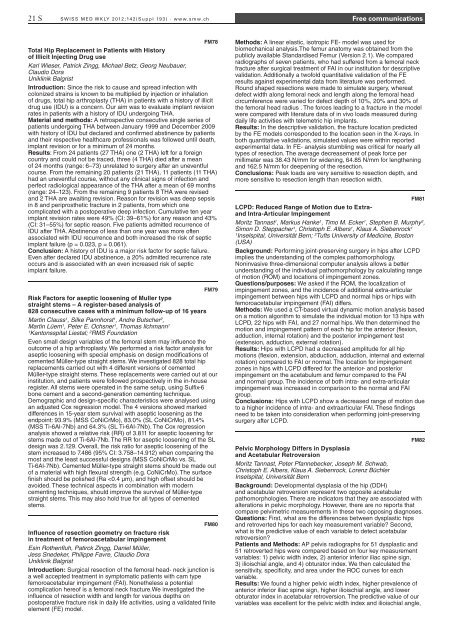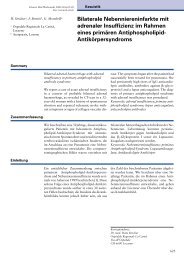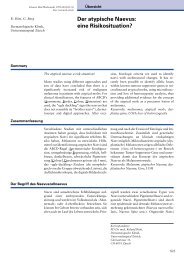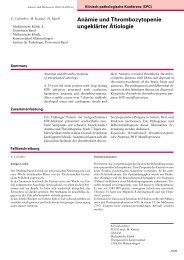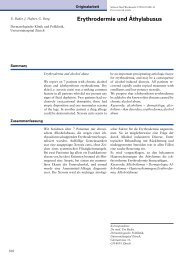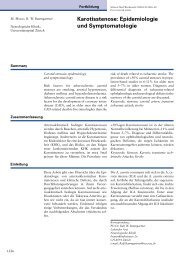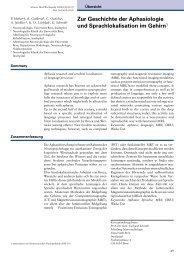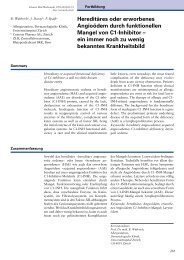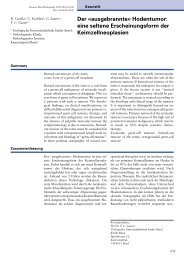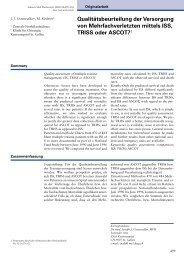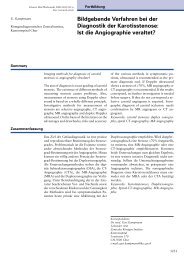SMW Supplementum 193 - Swiss Medical Weekly
SMW Supplementum 193 - Swiss Medical Weekly
SMW Supplementum 193 - Swiss Medical Weekly
Create successful ePaper yourself
Turn your PDF publications into a flip-book with our unique Google optimized e-Paper software.
21 S SWiSS Med Wkly 2012;142(Suppl <strong>193</strong>) · www.smw.ch Free communications<br />
FM78<br />
Total Hip Replacement in Patients with History<br />
of Illicit Injecting Drug use<br />
Karl Wieser, Patrick Zingg, Michael Betz, Georg Neubauer,<br />
Claudio Dora<br />
Uniklinik Balgrist<br />
Introduction: Since the risk to cause and spread infection with<br />
colonized strains is known to be multiplied by injection or inhalation<br />
of drugs, total hip arthroplasty (THA) in patients with a history of illicit<br />
drug use (IDU) is a concern. Our aim was to evaluate implant revision<br />
rates in patients with a history of IDU undergoing THA.<br />
Material and methods: A retrospective consecutive single series of<br />
patients undergoing THA between January 1999 and December 2009<br />
with history of IDU but declared and confirmed abstinence by patients<br />
and their respective healthcare professionals was followed until death,<br />
implant revision or for a minimum of 24 months.<br />
Results: From 24 patients (27 THA) one (2 THA) left for a foreign<br />
country and could not be traced, three (4 THA) died after a mean<br />
of 24 months (range: 6–73) unrelated to surgery after an uneventful<br />
course. From the remaining 20 patients (21 THA), 11 patients (11 THA)<br />
had an uneventful course, without any clinical signs of infection and<br />
perfect radiological appearance of the THA after a mean of 69 months<br />
(range: 24–123). From the remaining 9 patients 8 THA were revised<br />
and 2 THA are awaiting revision. Reason for revision was deep sepsis<br />
in 8 and periprosthetic fracture in 2 patients, from which one<br />
complicated with a postoperative deep infection. Cumulative ten year<br />
implant revision rates were 49% (CI: 39–61%) for any reason and 43%<br />
(CI: 31–55%) for septic reason. Five patients admitted recurrence of<br />
IDU after THA. Abstinence of less than one year was more often<br />
associated with IDU recurrence and both increased the risk of septic<br />
implant failure (p = 0.023, p = 0.061).<br />
Conclusion: A history of IDU is a major risk factor for septic failure.<br />
Even after declared IDU abstinence, a 20% admitted recurrence rate<br />
occurs and is associated with an even increased risk of septic<br />
implant failure.<br />
FM79<br />
Risk Factors for aseptic loosening of Muller type<br />
straight stems – A register-based analysis of<br />
828 consecutive cases with a minimum follow-up of 16 years<br />
Martin Clauss1 , Silke Pannhorst1 , Andre Butscher2 ,<br />
Martin Lüem1 , Peter E. Ochsner1 , Thomas Ilchmann1 1 2 Kantonsspital Liestal; RMS Foundation<br />
Even small design variables of the femoral stem may influence the<br />
outcome of a hip arthroplasty. We performed a risk factor analysis for<br />
aseptic loosening with special emphasis on design modifications of<br />
cemented Müller-type straight stems. We investigated 828 total hip<br />
replacements carried out with 4 different versions of cemented<br />
Müller-type straight stems. These replacements were carried out at our<br />
institution, and patients were followed prospectively in the in-house<br />
register. All stems were operated in the same setup, using Sulfix-6<br />
bone cement and a second-generation cementing technique.<br />
Demographic and design-specific characteristics were analysed using<br />
an adjusted Cox regression model. The 4 versions showed marked<br />
differences in 15-year stem survival with aseptic loosening as the<br />
endpoint: 93.9% (MSS CoNiCrMo), 83.0% (SL CoNiCrMo), 81.4%<br />
(MSS Ti-6Al-7Nb) and 64.3% (SL Ti-6Al-7Nb). The Cox regression<br />
analysis showed a relative risk (RR) of 3.811 for aseptic loosening for<br />
stems made out of Ti-6Al-7Nb. The RR for aseptic loosening of the SL<br />
design was 2.129. Overall, the risk ratio for aseptic loosening of the<br />
stem increased to 7.486 (95% CI: 3.758–14.912) when comparing the<br />
most and the least successful designs (MSS CoNiCrMo vs. SL<br />
Ti-6Al-7Nb). Cemented Müller-type straight stems should be made out<br />
of a material with high flexural strength (e.g. CoNiCrMo). The surface<br />
finish should be polished (Ra


